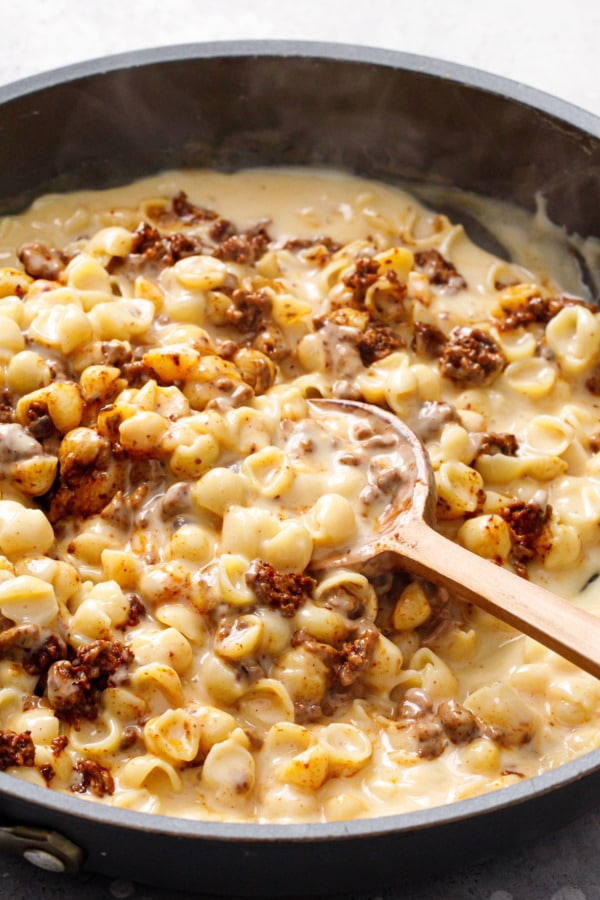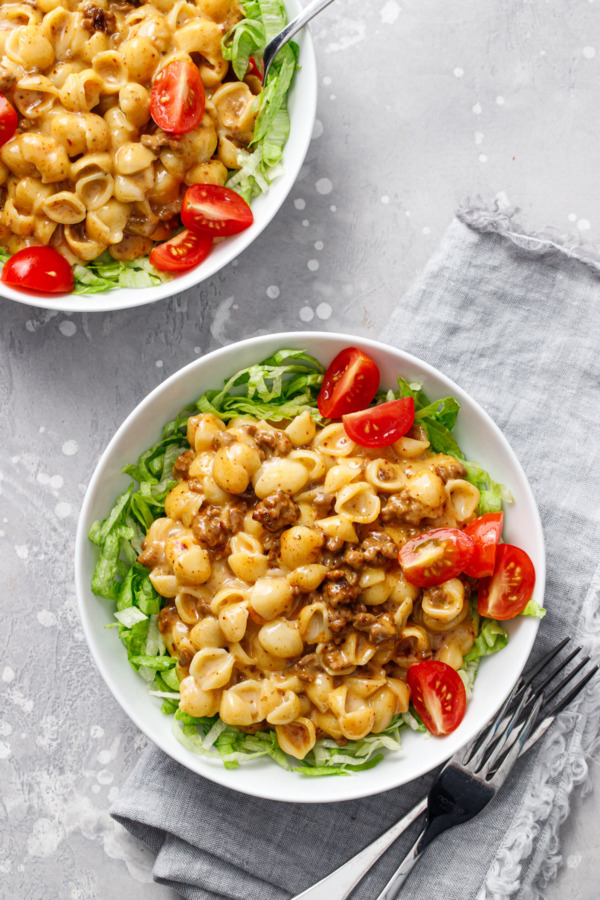Mac and cheese meets American-style beef tacos in this melty mashup of epic proportions.
Taco shells and cheese is a truly pun-derful recipe, featuring mini pasta shells smothered in a rich and creamy cheese sauce, swirled with spicy seasoned ground beef. Served atop of bed of crisp iceberg lettuce it’s ever so satisfying.
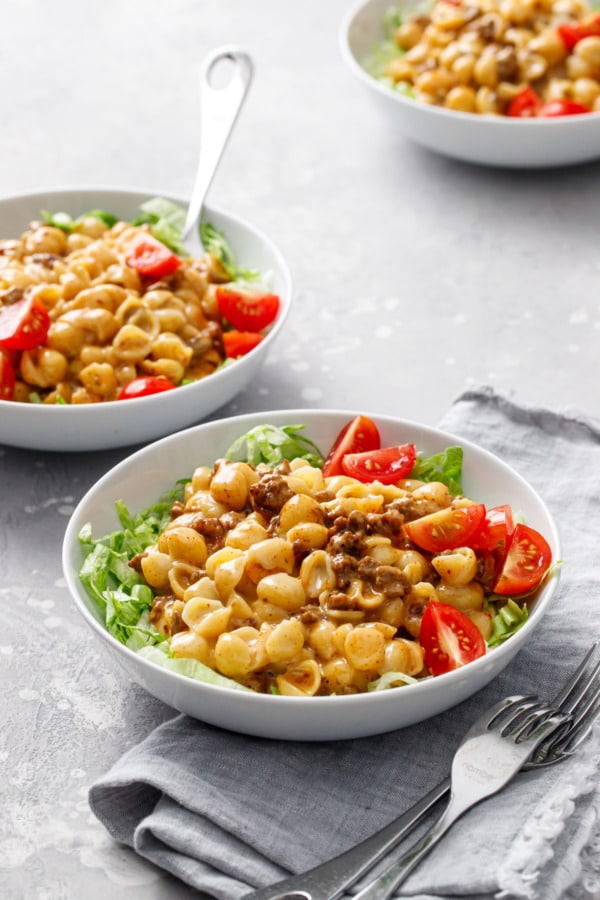
I swear, mac and cheese is harder to photograph than ice cream; the time between a perfectly rich and creamy sauce and a congealed mess feels like mere seconds. No matter how creamy it starts, as it cools the sauce will no longer have the same visual appeal… and that sort of time-sensitive recipe makes for a very stressful photo shoot.
We made this recipe upwards of half a dozen times. Photographed it twice. Which might seem like a lot of work for a recipe that is, in actuality, quite simple. But getting the right proportions of cheese sauce to pasta, not to mention the right amount of spice in the meat… took some effort to fine tune.
But all that work is totally worth it when the result is nothing short of perfection. Cheesy, spicy, perfection served atop a bed of shredded iceberg lettuce.
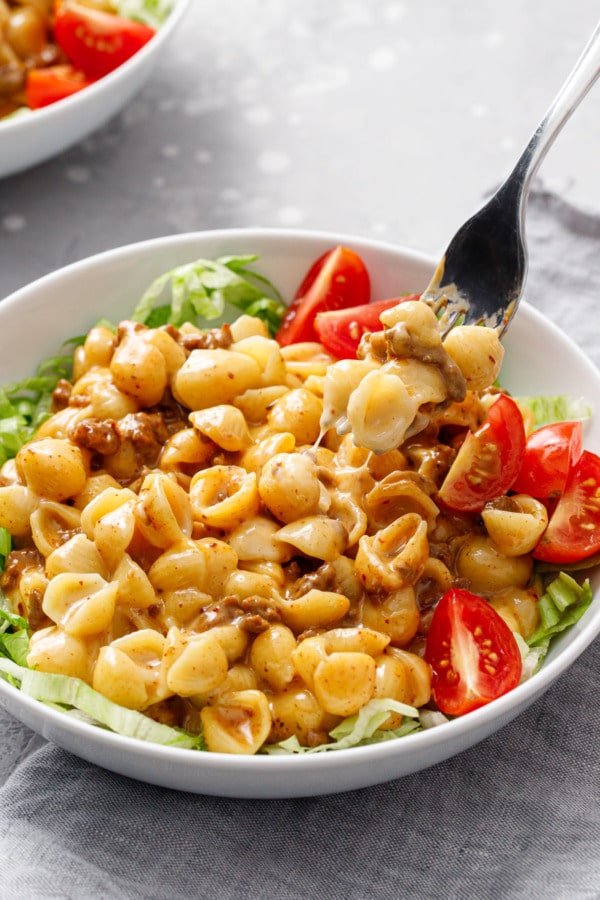
I am very particular about my mac and cheese. Texture is everything, and most roux-based recipes just don’t do it for me, going all pasty and weird within minutes of serving. Not to mention the greasy mess you’ll end up with if you try to reheat it the next day.
And while I love the beautifully creamy texture of boxed mac and cheese mix or mac made with a block or pouch of processed cheese product, the cheese flavor is always a bit… lacking. Not that it doesn’t taste like cheese, rather it tastes like cheese that’s trying too hard to taste like cheese, if that makes sense?
Enter… sodium citrate. The magical ingredient that will allow you to achieve the ultimate creamy shells and cheese and use any cheese you want. This method was popularized with the Modernist Cuisine cookbooks, wherein they basically extracted the ingredient that makes processed cheese creamy (aka sodium citrate) and added that to high quality cheeses to make a lusciously smooth cheese sauce for the best mac and cheese you’ll ever taste. Also, homemade nacho cheese. Seriously. Just go buy a tub of it right now while you’re thinking about it, then you’ll always have it on hand for when the cheese craving hits you.
Why use Sodium Citrate?
Cheese sauce made with sodium citrate comes together more easily and without the hassle of a roux or the worry of the sauce breaking or separating.
You can pretty much use any cheese you want, as long as it’ll melt. Cheddar, gruyere, fontina, and havarti are some of my favorites, but I’ve also made stellar macs with brie and even a touch of parmesan or pecorino for a really pronounced flavor.
It stays creamier for longer; keep it warm and, despite a little bit of skin forming, the sauce will stay luscious and smooth as long as you need it to.
It also reheats beautifully, compared to the greasy, separated mess that leftover mac and cheese often becomes (ew). The pasta does absorb a lot of liquid overnight, so the next day it won’t be quite as saucy, but it’ll still be creamy and not greasy in the least (alternatively, if you want to preserve the sauciness, spoon out half your sauce, meat, and pasta [or whatever you are not eating right away] and store in separate containers. The next day, reheat the components separately and then mix it altogether and it’ll be as good as if it were made fresh.)
It’s… pretty much magic. Golden, gooey, cheesy magic.
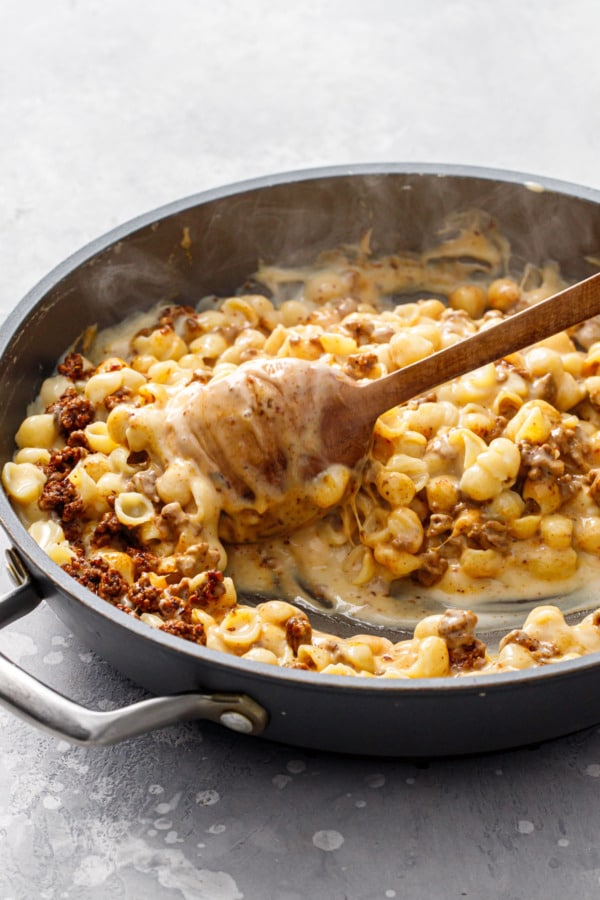
This recipe is technically a hybrid of a roux-based and a modernist-style mac ‘n cheese, using both flour and sodium citrate to produce a ridiculously creamy cheese sauce. When using sodium citrate you don’t technically need the flour, however I think a little bit helps thicken the sauce and improves the mouthfeel (sometimes these kinds of cheese sauces can feel a bit plasticky). It’s the best of both worlds.
Instead of a roux, which cooks flour with fat (and more often than not comes out oddly chunky), we make a paste of flour and a bit of milk, then add that to the pan with the rest of the milk. You can use the same pan that you used for the beef, in fact I recommend it as you’ll infuse the sauce with flavor leftover from the spiced beef.
Bring the milk to a simmer, then turn off the heat and add your cheese, a handful at a time. It should be plenty hot to melt all 8 ounces of cheese, but you can return it to low heat if necessary (one of the benefits of sodium citrate, remember, it’s ok to get hot!)
Once melted, add your cooked and drained pasta and the ground beef mixture and stir until everything is evenly coated with cheesy goodness.
While the sauce will thicken as it cools, the sodium citrate will prevent it from curdling or separating, especially when it is reheated. If you’ve ever reheated mac and cheese only to end up with a greasy mess, you know exactly what I mean.
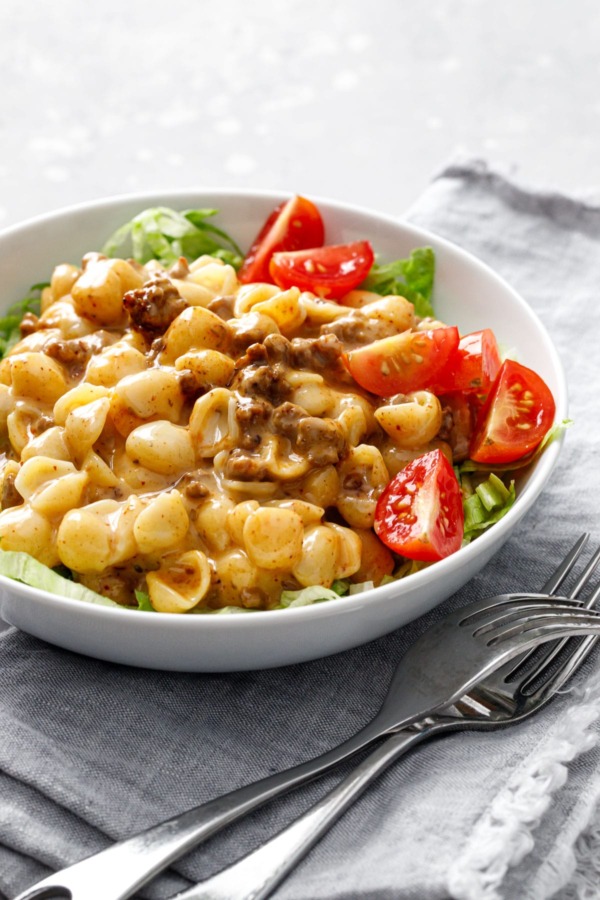
That said, if you must have taco shells this instant and don’t have any on hand, it can be left out, so long as you substitute at least half of the total cheese with a processed cheese product (like American or queso-style). (Tip: check your grocery deli counter, they often have blocks of American cheese by the pound, which you can then grate yourself and add to your cheese sauce much easier than the slices)
Because, guess what? Sodium citrate is the magical ingredient that makes processed cheeses melt so beautifully. So you’re still technically using it one way or another.
For the creamiest mac and cheese, use sodium citrate with the cheese or cheeses of your choice (I used Trader Joe’s Cheddar-Gruyere melange, but really, the beauty of sodium citrate is that any cheese works!) or, without the sodium citrate, as long as you use at least 50% processed cheese you should end up with a heaping bowl of creamy goodness.
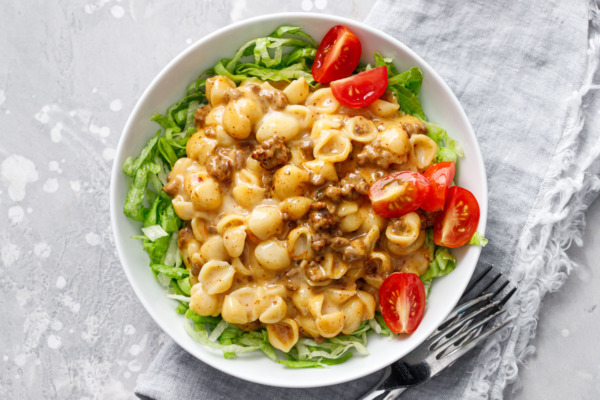
Taco Shells & Cheese
Mini pasta shells smothered in a rich and creamy cheese sauce, swirled with spicy seasoned ground beef, and served atop of bed of crisp iceberg lettuce.
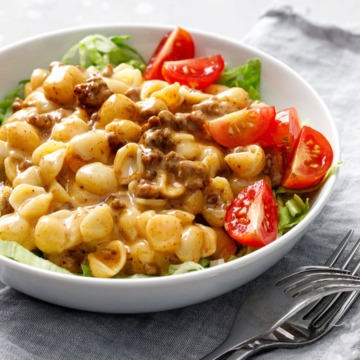
Ingredients:
- 8oz (226g) mini shell or elbow pasta, cooked according to package instructions
- 1/2 pound (8oz/226g) ground beef
- 1 tablespoon chili powder*
- 2 teaspoons ground chipotle chili powder
- 1 teaspoon ground cumin
- 1 teaspoon dried oregano
- ½ teaspoon kosher salt
- ¼ teaspoon ground coriander
- ¼ teaspoon ground cayenne pepper
- 1¾ cup whole milk
- 2 tablespoons (15g) all-purpose flour
- 2 teaspoons (11g) sodium citrate**
- 8oz (226g) shredded white cheese (about 2 cups shredded, I used a mix of white cheddar and gruyere)
- shredded iceberg lettuce and quartered cherry tomatoes, for serving
Directions:
- Bring a large pot of salted water to a boil.
- In a small bowl, whisk together all spices and salt until evenly distributed.
- In a large skillet or saucepan set over medium heat, cook ground beef until mostly cooked through, about 5 minutes, breaking it up into small pieces with a spoon. Sprinkle over spice mixture and stir to coat. If your beef is on the lean side and the meat feels a bit dry, you can add a splash of water to loosen it up.
- Once beef is cooked through and coated with spices, use a slotted spoon to transfer to a bowl and set aside. Return skillet to medium heat.
- In a small bowl, make a paste with flour and 2 tablespoons of milk, then add it to the pan with the rest of the milk and sodium citrate, whisking until evenly incorporated. Continue to cook over medium heat, whisking occasionally, until it comes to a simmer.
- Add your pasta to the boiling water and cook until al dente (typically 1 minute less than the package instructs). Ideally you want to time it so the pasta is done at the same time as the cheese sauce, though the sauce will hold over low heat as long as you need it to.
- When the milk starts simmering, turn off the heat and add your cheese, a handful at a time, whisking until fully melted before adding another handful. The milk should be plenty hot to melt all of the cheese, but you can return it to low heat if necessary to melt the rest of the cheese, or to keep it warm until the pasta is done.
- Once fully melted, add your cooked and drained pasta and stir until everything is evenly coated with cheesy goodness. Fold in ground beef mixture. Serve immediately on a bed of or topped with shredded iceberg lettuce, and top with cherry tomatoes as desired.
*This recipe calls for American-style chili powder, which is actually a blend of ground chilies and other spices. Don’t use pure ground chilis (which I’ve heard is commonly labeled chili powder in other countries) which would be far too spicy in this recipe. Also keep in mind that different brands of chili powder have different spice and salt levels, so feel free to adjust the seasoning to taste (maybe start with half a tablespoon and go from there).
**Sodium citrate can be found online or in some specialty grocers. I highly recommend tracking it down as it makes for the best mac and cheese. If you opt to leave it out, replace all or at least half of the cheese called for in this recipe with a processed cheese such as American or queso-melt.
Did you make this recipe?
Let us know what you think!
Leave a Comment below or share a photo and tag me on Instagram with the hashtag #loveandoliveoil.
